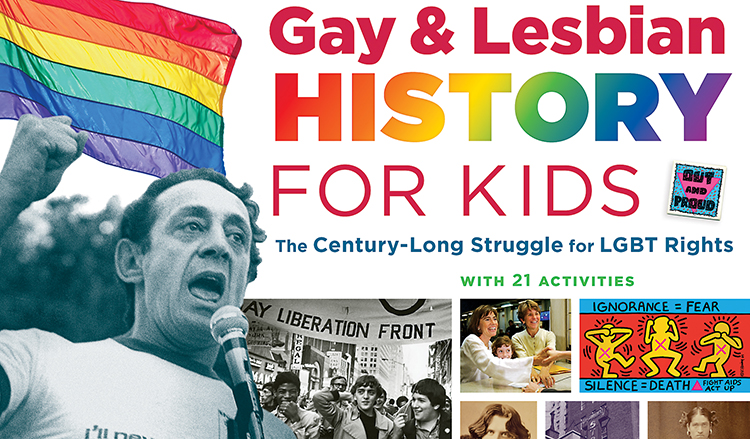
The full title is, Gay & Lesbian History for Kids: The Century-Long Struggle for LGBT Rights, With 21 Activities. We’ll get to the activities part. First, as this is a history and reference book for children, I want to break down my impressions.
Layout: Are kids going to want to read this? Is it attractive? It’s a manageably sized paperback in landscape format with a 4-color cover; good start. The interior isn’t 4-color, but it’s 2-color (magenta and black). There’s plenty of visual interest, and the text is broken up appropriately and attractively. Useful and relevant sidebars also add appeal.
Organization: Chronological. The first three chapters cover up until 1960 (chapter one is “a brief history to 1900”), and each decade thereafter gets its own chapter. The content is paced well. There are other important features to consider in children’s nonfiction, though. The table of contents is easy to read, and a two-page timeline follows, summarizing much of the content covered in the book. There’s a short, but well-chosen, resources section, and lots of notes, and wonder of wonders, a useful index, which I used at least twice. There’s also a short introduction featuring a scenario that’s wrapped up in the afterword. It pulls kids in, and later gives them a happy ending.
Content: The table of contents doesn’t give chapter subheadings to clue readers in to what’s going on within chapters; it lists only one title and what decades are covered and then gives page numbers for corresponding activities. So the timeline on the next page is very useful in getting an idea of what the book covers. The first event marked is the death of Sappho, and only a few dates later, we’re solidly in the 1900, ending a page and a half later in 2015 with the Obergefell v. Hodges decision. Pohlen explains that of necessity, well-documented LGBT history coverage started only within the 1900s, and although there’s much historical speculation, that’s all it is–speculation. The book is useful in providing some avenues and figures that may pique interest (Emily Dickinson, Katharine Lee Bates, Leonardo da Vinci), but doesn’t go into much detail. A small section about two-spirit people in the first chapter is particularly interesting.
The first chapter contains more of a world perspective, but once Pohlen gets down to it, it’s clear this is really the story of a century-long battle on the American front. And the story covers all the major bases one would expect and hope to find, and in clear and engaging prose. The content and writing are supposedly appropriate for ages 9 up, but I’m not sure many 9-year-olds would stick with it. Middle graders seem like a better audience, even given Pohlen’s penchant for inserting an exclamation point every now and then. Middle graders would also appreciate the non-busy layout for research purposes. If it’s weapons or flags or Legos, the busier the better (Dorling Kindersley!), but for research, straightforward and easy-to-follow books are greeted with relief. The activities are the only point of contention. More later. The book does contain content on Ls, Gs, Bs, and Ts, but doesn’t go beyond four consonants, and most of the book is Gs and Ls.
Authoritativeness: Pohlen has already had a title on the VOYA Nonfiction Honor List, and the afterword makes clear this one is close to his heart. He’s the right guy to have written a book that’s factually correct and primarily neutral in tone–it’s curriculum-adoptable in terms of the basic text.
Entertainment factor: I struggle with this one. Kids don’t generally sit down with nonfiction for the fun of it. (I don’t, either, with some exceptions.) But this was really engaging material, and the age group that would probably be using this book tends to get fired up about injustice–they might take to it more strongly than predicted.
Activities: This is where the book did not work for me. I understand the concept of making history participatory, and “enlivening” it. But the material is already in capable hands. The tie-ins for some of the activities make sense (“Remember a loved one with a quilt panel”). Some are kind of cool (“The high five”). Kids can learn about designing a flag, or boycotting something, or reading banned books. But conducting an inkblot test or finding a constellation seem like they may be reaching. Many of the activities didn’t seem integrated. However, many were designed to help kids learn about methods of protest or of effecting positive social change, which seems to fit. Some are better than others. The boycott activity was phrased particularly effectively and seemed like it would go a long way toward starting excellent conversations.
Quibbles:
Photos on title page, table of contents pages, and timeline lack captions and credits./Photos all appear later in the book with captions and credits.
“Other rallies were held in cities like Cincinnati, Ohio, and Dallas.” Only two of these things jumped out at me in the whole book (the other was an affect/effect thing), but that’s still two too many for something I would use in a classroom.
Final thoughts: Well, isn’t this something! Great timing for a book of this nature, and something my library certainly has…none of. What about yours? I like this book and wish something like it had been around while I was growing up. This version, though it notes next steps that need to be taken and more progress to be made, ends on such a high note. Get it for the kids in your family and recommend it to your local library, as there is a paucity of books on this subject for this audience, and this is actually a very nice title.
